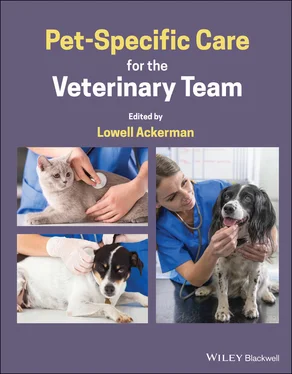2.20.3 Cancer is a Disease of Dysregulated Genes
It is clear that cancer is a disease of dysregulated genomics. New genomic characterizations of cancer (combined with dramatic reductions in the cost of genomic analysis and computing power, and the parallel genomic and biological annotation, i.e., “naming,” of cancer‐associated genes) has fueled the field of precision medicine as a therapeutic approach, delivered recent drug approvals in human oncology, and is increasingly available to all species of cancer patients.
2.20.3.1 Precision Medicine for Oncology
In many disease conditions, it is well understood that conventional methods of disease characterization are insufficient to fully inform clinicians of an individual patient's needs. For the most part, the genomic characterization of many disease states can better account for these needs. As such, Pmed can allow clinicians to select better initial approaches to therapy, more rapidly alter treatment approach, and individualize plans for disease monitoring. From the perspective of need and opportunity, the field of oncology is most ready and in need of this evolution in medicine. Collectively, this has created the opportunity for relatively inexpensive genomic and molecular characterizations of disease states.
2.20.4 Cancer Precision Medicine for Individualized and Molecular Therapy
In the delivery of Pmed, a tissue biopsy or blood sample (liquid biopsy) from the patient will be used to extract nucleic acids for genomic sequencing. Altered genes are prioritized as therapeutic targets. These are then matched with specific drugs that inhibit the altered gene or its pathway. An individualized cocktail of therapeutics, matched to the patient's cancer genome, is then delivered to the patient. Adjustments can then be made after reanalysis of liquid biopsy signals.
2.20.5 Challenges and Solutions for Precision Medicine and Veterinary Oncology
Challenges to the field of precision medicine, and more generally to molecularly targeted therapy, must be addressed before this important and novel approach to cancer therapy will improve outcomes. These challenges include, but are not limited to, the following.
Cancer evolution. Most precision medicine platforms analyze patient tissue from a primary tumor resection. As a consequence, subsequent molecular treatment is based on the characteristics of a patient's primary tumor. Unfortunately, metastases from a primary tumor often exhibit distinct molecular alterations compared to the initial primary tumor. Accordingly, a therapy that targets a primary tumor may not necessarily control the associated metastatic progression that is a problem for patients. Since most patients require therapeutics that target the molecular alterations that result in metastatic progression, it is very unlikely that analysis of the primary tumor or even a measurable metastatic lesion will deliver a valuable therapeutic response in that patient.
Cancer geography. Within a single tumor, multiple populations of cancer cells can exist that differ in the genetic alterations they express. Because of this geographic heterogeneity within a tumor, it remains unclear if molecular analysis of a single portion of a tumor can sufficiently represent the tumor as a whole. As such, genetic analysis of a single biopsy sample may result in therapeutic recommendations that only target a subset of cells within a tumor. This could result in poor patient response to treatment. With this in mind, determining the most valuable and informative portions of tissue for molecular analysis is critical for effective Pmed. Evidence from many genomic studies suggests that this problem of geographic heterogeneity is cancer specific and will require studies in specific cancers to determine optimal biopsy recommendations for Pmed.
2.20.5.1 The Liquid Biopsy Solution
A reasonable solution to the problems of cancer geography and evolution may be delivered through the identification of cell‐free circulating tumor DNA. This can be accomplished through liquid biopsies, which are blood samples that contain circulating tumor DNA obtained from cancer patients. This technique is not only less invasive (only requires peripheral blood draws) but may be a more valuable approach to define the molecular events driving cancer progression, i.e., using the abundance of the mutated tumor DNA in the blood to guide optimal Pmed drug selection. Accordingly, a Pmed platform that does not include analysis of cell‐free circulating tumor DNA in blood is not likely to optimally improve treatment outcomes.
A critical but often ignored problem in the field of precision medicine is the growing understanding that specific genomic alterations (i.e., mutations) in a given cancer influence the biology of that cancer in the context of that cancer. In other words, a given genetic mutation may affect tumors differently depending on which type of cancer the patient has. Thus, the therapeutic value of targeting specific mutations is dependent on the cancer type in question. We should not be surprised that an understanding of context will also be species specific, and not necessarily predicted by genomic studies alone.
2.20.6 Cancer Precision Medicine for Reverse Drug Development
This is a more immediate application of cancer precision medicine than simply using it as a means to identify a specific treatment for a single patient. Pmed can also be used to form the scientific rationale for new drug development that starts with the cancer patient rather than cancer cells in tissue culture. This new approach to future cancer drug development should accelerate efforts within specific cancers. This is in contrast to a traditional and much slower drug discovery/development path which most often begins in cell‐based studies and then progressively moves to cancer patients.
2.20.7 Are You Ready to Interpret a Pmed Analysis of Disease?
Considering all the factors discussed above, it is important for all veterinary clinicians to decide if they are effectively prepared to offer Pmed services to their veterinary oncology patients. As described above, a variety of Pmed offerings are commercially available and more clients will request advice on the use of these options. At this time and in the future, clinicians should assess their ability to interpret and act on Pmed data and drug reports. Ideally, practitioners should have access to a multidisciplinary team of veterinary scientists and clinicians to deliver the best value to patients from these types of complex data (see 8.26Team Strategies for Cancer). These teams should be led by veterinary scientists with experience in molecular biology, drug development, pathology, and medicine. Leveraging this expertise within the veterinary field is paramount, since professionals in the human field will likely have insufficient background and context to deliver effective interpretations of data to veterinary clinicians and patients.
 TAKE‐AWAYS
TAKE‐AWAYS
Precision cancer medicine can be utilized to improve our understanding of a patient's cancer. By identifying genetic alterations within a tumor that may be responsible for cancer progression and aggressive behavior, delivering personalized and molecularly guided therapy (i.e., targeted therapy) seeks to align effective drugs that target specific molecular alterations with patients whose tumors express those molecular alterations.
Two patients may have the same histological type of cancer, but the genetic mutations of their cancers may differ. This can affect the response to a given therapy between the two individuals.
Читать дальше

 TAKE‐AWAYS
TAKE‐AWAYS










